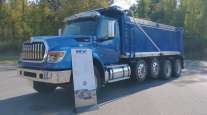Senior Reporter
First Profit for Navistar Since 2012
This story appears in the June 13 print edition of Transport Topics.
Truck and engine manufacturer Navistar International Corp. reported its first profit since the fiscal third quarter of 2012.
 John Sommers II for Transport Topics
John Sommers II for Transport TopicsFor the fiscal second quarter ended April 30, Navistar posted net income of $4 million, or 5 cents per share, on the strength of its parts and financial services segments. That compares with a net loss of $64 million, or 78 cents, in the year-earlier period.
The Lisle, Illinois-based company, parent of the International truck brand, said revenue for the quarter was $2.2 billion, down 18% compared with $2.7 billion in the second quarter of last year.
Navistar, which announced the results June 7, said the decline in revenue reflected lower volumes in U.S. and Canadian markets due to softening industry conditions and the discontinuation of its Blue Diamond Truck joint venture with Ford Motor Co.. The decrease also was attributed to lower engine volumes in Brazil because of ongoing weak economic conditions in that country.
“I think this quarter begins to demonstrate the earnings potential of this company,” CEO Troy Clarke said during an earnings conference call about the first profit since the third quarter of 2012.
Wall Street cheered the news as shares of Navistar rallied 20% to $14.54 after some 5 million shares exchanged hands by the close of trading June 7. The average volume had been 1.2 million over three months of trades, according to the New York Stock Exchange.
“The fact that we made a profit in Q2 despite lower Class 8 truck volumes that impacted the entire industry underscores the tremendous progress we continue to make,” Clarke added.
The company’s future was uncertain not too long ago. Its choice to meet a new round of engine emissions regulations in 2010 by continuing to use exhaust gas recirculation technology to slash emissions of nitrogen oxides and particulate matter — while other engine manufacturers turned from EGR to selective catalytic reduction and diesel particulate filters — was a disaster. Its International brand’s Class 8 market share plummeted as the Environmental Protection Agency declined to certify the company’s 13-liter engine using EGR. In 2012, Daniel Ustian, then Navistar’s chairman, president and CEO, left the company as operating losses mounted to $616 million over nine months. Warranty issues eventually soared into the hundreds of millions of dollars, too, and continue to be dealt with (the original equipment manufacturer now uses selective catalytic reduction). Lawsuits against the company burgeoned. In April, Navistar agreed to pay $7.5 million to settle a Securities and Exchange Commission complaint that the OEM misled investors about the environmental compliance of its EGR engine. Some civil litigation related to its choice of EGR continues.
The latest quarterly earnings report shows how the company has advanced under new leadership.
Clarke was promoted to CEO in 2013, from chief operating officer and president. He joined the company in 2010 after 35 years with General Motors.
He said Navistar was now pressing ahead “to address what we and everyone else in the industry is seeing: much more difficult industry conditions than anyone anticipated.”
Two of the company’s four main business units were profitable in the quarter. The parts segment saw net income climb to a quarterly record of $176 million, up from $133 million a year earlier. The financial services unit’s profit rose to $25 million from $22 million in the year-earlier period, according to Navistar.
The parts segment’s profit, up 32% compared with the same period one year ago, primarily was due to margin improvements and cost-reduction initiatives, the company said.
Meanwhile, the truck unit showed a loss of $23 million compared with a decline of $51 million a year earlier; and global operations reported a loss of $1 million, reversing a $1 million profit in the same period one year ago, according to the OEM.
The company said its truck segment’s loss narrowed due to lower structural cost, improved mix, lower accelerated depreciation charges and other income, which were partially offset by higher year-over-year adjustments to pre-existing warranties and an increase in used-truck reserves.
Clarke said excluding the pre-existing warranty adjustment, the truck segment “would have been profitable in the quarter for the first time since we started our turnaround.”
For the second half of 2016, Navistar lowered its industry guidance by 20,000 units due to softening Class 8 market conditions. The company said it now forecasts Class 8 demand in North America in 2016 to be 220,000 to 250,000 units compared with its prior guidance of 240,000 to 270,000.
“We are confident we will generate and implement additional performance improvements to partially offset current industry conditions,” Clarke said.
The company said it achieved $56 million in structural cost reductions during the second quarter, while year-to-date, structural cost reductions are at $113 million.
When combined with material spend reductions and manufacturing savings, the company is on track to well exceed its total cost reduction goal of $200 million for 2016, Navistar said.




